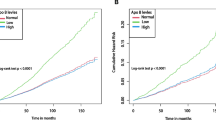Abstract
Apelin is a bioactive mediator released by adipose tissue that can be involved in energy metabolism events and coronary artery disease. This study aims to investigate the role of serum apelin levels in patients with peripheral artery disease (PAD). The present observational case–control study consisted of 100 subjects (50 angiographically proven PAD patients and 50 healthy controls). Serum apelin and apelin receptor (APJ) levels were measured with blood samples. Clinical and laboratory findings were obtained from the hospital database system. The association between serum apelin levels, and PAD was investigated. The number of smokers and subjects with hypertension, coronary artery disease and diabetes mellitus was higher in the PAD group than in the control group (P < 0.05). Mean serum apelin levels were lower in the peripheral artery group than in the control group (mean: 13.94, SD 4.34 vs. mean: 16.79, SD 4.2, P = 0.001). On the other hand, the mean APJ levels were higher in the control group (mean: 36.1, SD 19.1 vs. mean: 27.7, SD 13.1, P = 0.019). There was no statistically significant difference between the two groups (20 (41.6%) vs. 21 (42%), P = 973) regarding the obesity. Our findings revealed that hypertension, smoking and diabetes mellitus rates were higher among patients with PAD. In fact, the lower apelin levels and higher APJ levels were risk factors associated with PAD; the obesity was not related with development of PAD.
Similar content being viewed by others
References
Fowkes FG, Rudan D, Rudan I et al (2013) Comparison of global estimates of prevalence and risk factors for peripheral artery disease in 2000 and 2010: a systematic review and analysis. Lancet 382:1329–1340
Kullo IJ, Rooke TW (2016) Peripheral artery disease. N Engl J Med 374:861–871
American Diabetes Association (2003) Peripheral arterial disease in people with diabetes. Diabetes Care 26:3333–3341
Alzahrani HA, Wang D, Bakhotmah BA, Hu FB (2014) Risk factors for peripheral artery disease among patients with diabetes in Saudi Arabia. Vasc Med 19(2):103–111
Japp AG, Cruden NL, Barnes G, van Gemeren N, Mathews J, Adamson J et al (2010) Acute cardiovascular effects of apelin in humans: potential role in patients with chronic heart failure. Circulation 121:1818–1827
Maguire JJ, Kleinz MJ, Pitkin SL, Davenport AP (2009) [Pyr1]apelin-13 identified as the predominant apelin isoform in the human heart: vasoactive mechanisms and inotropic action in disease. Hypertension 54:98–604
Falcao-Pires I, Leite-Moreira AF (2005) Apelin: a novel neurohumoral modulator of the cardiovascular system: pathophysiologic importance and potential use as a therapeutic target. Rev Port Cardiol 24(10):1263–1276
Szokodi I, Tavi P, Foldes G, Voutilainen-Myllyla S, Ilves M, Tokola H et al (2002) Apelin, the novel endogenous ligand of the orphan receptor APJ. regulates cardiac contractility. Circ Res 91(5):434–440
Kadoglou NP, Lampropoulos S, Kapelouzou A, Gkontopoulos A, Theofilogiannakos EK, Fotiadis G, Kottas G (2010) Serum levels of apelin and ghrelin in patients with acute coronary syndromes and established coronary artery disease–KOZANI STUDY. Transl Res 155(5):238–246
(2017) 2017 ESC Guidelines on the diagnosis and treatment of peripheral arterial diseases. Developed in collaboration with the European Society for Vascular Surgery (ESVS). Eur Heart J 39(9):763–816
Criqui MH, Aboyans V (2015) Epidemiology of peripheral artery disease. Circ Res 116:1509–1526
Bauersachs R, Zeymer U, Brière JB, Marre C, Bowrin K, Huelsebeck M (2019) Burden of coronary artery disease and peripheral artery disease: a literature review. Cardiovasc Ther 2019;26:8295054
Aguilar-Salinas CA, García EG, Robles L, Riaño D, Ruiz-Gomez DG, García-Ulloa AC et al (2008) High adiponectin concentrations are associated with the metabolically healthy obese phenotype. J Clin Endocrinol Metab 93(10):4075–4079
Guh DP, Zhang W, Bansback N, Amarsi Z, Birmingham CL, Anis AH (2009) The incidence of co-morbidities related to obesity and overweight: a systematic review and meta-analysis. BMC Public Health 25(9):88
Bełtowski J (2006) Apelin and visfatin: unique “beneficial” adipokines upregulated in obesity? Med Sci Monit 12(6):RA12-119
Yue P, Jin H, Xu S, Aillaud M, Deng AC, Azuma J et al (2011) Apelin decreases lipolysis via Gq. Gi. and AMPK-dependent mechanisms. Endocrinology 152:59–68
Than A, Zhang X, Leow MK, Poh CL, Chong SK, Chen P (2014) Apelin attenuates oxidative stress in human adipocytes. J Biol Chem 289(6):3763–3774
Lv S, Feng Y, Jiang Q, Lv X, Yang Y (2021) Relationship between Apelin/APJ signaling, oxidative stress, and diseases. Oxidative Med Cell Longev 2021:1–7
Akcilar R, Yumun G, Bayat Z, Donbaloglu O, Erselcan K, Ece E, Kokdasgil H, Genc O (2015) Characterization of the apelin -1860T>C polymorphism in Turkish coronary artery disease patients and healthy individuals. Int J Physiol Pathophysiol Pharmacol 7(4):165–171
Li Z, Bai Y, Hu J (2008) Reduced apelin levels in stable angina. Intern Med 47(22):1951–1955
Chen T, Wu B, Lin R (2017) Association of apelin and apelin receptor with the risk of coronary artery disease: a meta-analysis of observational studies. Oncotarget 8(34):57345–57355
Lee DK, Saldivia VR, Nguyen T, Cheng R, George SR, O’Dowd BF (2005) Modification of the terminal residue ofapelin-13 antagonizes its hypotensive action. Endocrinology. 146(1):231–236
Kaplan M, Yavuz F, Kaplan GI, Bursa N, Vuruşkan E, Sucu M (2021) Elabela as a novel marker: well-correlated with WIfI amputation risk score in lower extremity arterial disease patients. Anatol J Cardiol 25(5):330–337
Butruille L, Drougard A, Knauf A, Moitrot E, Valet P, Storme L, Deruelle P, Lesage J (2013) The apelinergic system: sexual dimorphism and tissue-specific modulations by obesity and insulin resistance in female mice. Peptides 46(1):94–101
Funding
This study was supported by the Namık Kemal University Research Fund (Project no: NKUBAP.02.GA.18.169).
Author information
Authors and Affiliations
Corresponding author
Ethics declarations
Conflict of Interest
The authors declare no competing interests.
Additional information
Publisher's Note
Springer Nature remains neutral with regard to jurisdictional claims in published maps and institutional affiliations.
Rights and permissions
About this article
Cite this article
Yümün, G., Gürkan, S., Yilmaz, A. et al. The Role of Serum Apelin Levels in Peripheral Artery Disease. Indian J Surg 85 (Suppl 1), 214–218 (2023). https://doi.org/10.1007/s12262-022-03370-y
Received:
Accepted:
Published:
Issue Date:
DOI: https://doi.org/10.1007/s12262-022-03370-y




